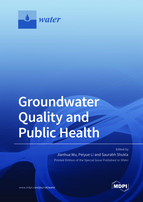Groundwater Quality and Public Health
A special issue of Water (ISSN 2073-4441). This special issue belongs to the section "Water and One Health".
Deadline for manuscript submissions: closed (30 June 2022) | Viewed by 27251
Special Issue Editors
Interests: groundwater quality; aquifer permeability; groundwater modeling; hyrogeochemistry; hydrogeology
Special Issues, Collections and Topics in MDPI journals
Interests: water resources; hydrogeology; groundwater quality; groundwater pollution; groundwater modeling; health risk assessment; geochemical modeling; hyrogeochemistry
Special Issues, Collections and Topics in MDPI journals
Interests: fate and transport of pollutants in the natural environment; hydrogeology; environmental geochemistry; GIS; nanotechnology; nanoremeditaion; water and wastewater treatment
Special Issue Information
Dear Colleagues,
Groundwater is a primary source of water for nearly half of the world’s population. Its quality has become as important as its quantity, as serious groundwater pollution has been identified in many regions and countries of the world. The contaminants in groundwater generally have two sources: one is geogenic origin and the other is human activities. The contaminants in groundwater can seriously affect human health, inducing a number of waterborne diseases. This Special Issue “Groundwater Quality and Public Health” attempts to provide a platform for researchers, policy makers, and engineers to share their latest thoughts and new findings on this topic, as well as new methods to address groundwater pollution. The Special Issue will focus on understanding the relationship between groundwater qualty and public health, and the current state of knowledge on the links between geological/geochemical processes and human health in the world. The factors accelerate or deccelerate the geological/geochemical processes, thus affected human health will also be considered. The topics covered by this Special Issue include but are not limited to:
- Hydrogeochemical processes and water quality;
- Water quality and waterborne diseases;
- Risks of groundwater contamination to the environment and to human health;
- Trace metal contamination and human/ecological risks;
- Climate change impacts on groundwater quality;
- Human activities and geological/geochemical processes.
Dr. Jianhua Wu
Dr. Peiyue Li
Dr. Saurabh Shukla
Guest Editors
Manuscript Submission Information
Manuscripts should be submitted online at www.mdpi.com by registering and logging in to this website. Once you are registered, click here to go to the submission form. Manuscripts can be submitted until the deadline. All submissions that pass pre-check are peer-reviewed. Accepted papers will be published continuously in the journal (as soon as accepted) and will be listed together on the special issue website. Research articles, review articles as well as short communications are invited. For planned papers, a title and short abstract (about 100 words) can be sent to the Editorial Office for announcement on this website.
Submitted manuscripts should not have been published previously, nor be under consideration for publication elsewhere (except conference proceedings papers). All manuscripts are thoroughly refereed through a single-blind peer-review process. A guide for authors and other relevant information for submission of manuscripts is available on the Instructions for Authors page. Water is an international peer-reviewed open access semimonthly journal published by MDPI.
Please visit the Instructions for Authors page before submitting a manuscript. The Article Processing Charge (APC) for publication in this open access journal is 2600 CHF (Swiss Francs). Submitted papers should be well formatted and use good English. Authors may use MDPI's English editing service prior to publication or during author revisions.
Keywords
- groundwater quality
- geochemical processes
- groundwater pollution
- health risk quantification
- water-borne diseases
- groundwater vulnerability
- groundwater quality management
- groundwater quality protection policy
- freshwater sanitation








